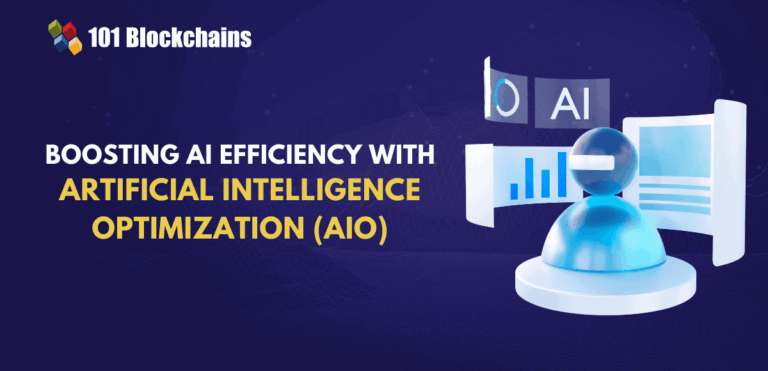The rapidly evolving AI landscape has introduced artificial intelligence into our everyday lives and various industries. AI is not a futuristic concept anymore as it offers the foundation to create intelligent chatbots, autonomous vehicles and sophisticated recommendation engines. The emphasis on artificial intelligence optimization or AIO is essential for long-term growth of AI as it ensures that AI systems work at par with benchmarks for efficiency and reliability. Why do you think AIO has emerged as a prominent trend in the domain of technology in 2025? Let us find the answer by learning more about AIO and its significance.
Unlock your potential in Artificial Intelligence with the Certified AI Professional (CAIP)™ Certification. Elevate your career with expert-led training and gain the skills needed to thrive in today’s AI-driven world.
Definition of Artificial Intelligence Optimization
Many of you must have thought that the applications of AI revolve only around language models like ChatGPT or Google Gemini. At the same time, you can find sophisticated AI systems, which are complex and demand more computational resources. Businesses must ensure that their AI systems are more accurate, faster, and more efficient, thereby providing optimal value to users.
The answers to “What is AIO in artificial intelligence?” describe it as a strategic process to improve reliability, performance, and efficiency of AI models and systems. The most interesting thing about artificial intelligence optimization is that the process continues throughout the lifecycle of AI models and systems.
AIO focuses on more than building the best AI models as it involves continuous fine-tuning of the models and making them capable of delivering the best results. Some experts also consider AIO as the process of optimizing digital content for AI systems. However, this article considers AIO as a broader technical discipline responsible for enhancing AI systems.
Crucial Principles Underlying AIO
The effectiveness of AIO in improving the performance of AI systems is the result of a comprehensive optimization schedule. The optimization of AI systems calls for optimizing models, computational resources, and the overall operational framework and data pipelines used in the systems. You should know about the following principles of AI optimization to understand its significance for the long-term growth of AI.
Artificial intelligence optimization focuses on reducing computational resources used in AI systems without any compromise in performance levels, thereby ensuring enhanced efficiency.
AIO also relies on the principle of generalization to ensure that AI models can perform effectively on new data.
The next important principle of AIO is accuracy, which implies the necessity of drawing correct decisions, responses or predictions from AI systems.
Another notable principle of AIO is scalability, which aims to empower AI systems to manage increasing data volumes and workloads without any impact on performance. AIO also aims to empower AI systems to process more requests in lesser time, thereby increasing throughput which enhances scalability.
Artificial intelligence optimization is incomplete without complying with the principle of reliability. The principle of reliability in AIO implies that AI systems deliver consistent performance while maintaining resilience to different inputs.
Want to develop the skill in ChatGPT to familiarize yourself with the AI language model? Enroll now in ChatGPT Fundamentals Course!
Reasons to Embrace Artificial Intelligence Optimization
Why did no one think about AIO when artificial intelligence applications had just started entering the market? The rising popularity of artificial intelligence optimization techniques can be attributed to the challenges associated with AI systems. The following reasons can help you figure out why AIO has become necessary for businesses that adopt AI systems.
AI models require significantly higher amount of computational resources for training and their various functionalities. You will need high-end computational power to drive advanced AI models. Without optimization, the advanced AI systems can end up suffering from extended processing times and higher costs.
Creating an AI model and deploying it in real-world use cases are completely different things. Models that perform exceptionally well in controlled environments might not be effective in real-world scenarios. The variations in resource constraints, data quality and latency requirements in different use cases create formidable setbacks for deployment without artificial intelligence optimization.
The most important reason to introduce artificial intelligence optimization algorithms is the burden of increasing competition. Almost every business wants the edge over their competition with more accurate, scalable and efficiency AI systems. At the same time, businesses must ensure that their AI systems work within the boundaries of ethics. Artificial intelligence optimization helps in ensuring responsible AI deployment while enhancing the competitive advantage of businesses.
Want to understand the importance of ethics in AI, ethical frameworks, principles, and challenges? Enroll now in Ethics Of Artificial Intelligence (AI) Course!
Discovering the Impact of AIO on Performance of AI Systems
Just like SEO involves a comprehensive collection of procedures to increase the visibility of a website in search results, AIO also follows a multifaceted approach. Rather than offering a single solution, artificial intelligence optimization focuses on the following elements to improve performance of AI systems.
Refining the Data for AI Systems
The most crucial factor responsible for performance of AI systems is data quality. You can find artificial intelligence optimization algorithms that showcase the perfect blend of data cleaning, preprocessing, augmentation and feature engineering. Data cleaning and preprocessing refines the training data by removing noise, transforming data into suitable formats and managing the missing values. AIO also includes data augmentation to optimize the training data for AI models and systems by expanding the training dataset.
One of the distinct aspects of data optimization in AIO is feature engineering, which involves selection, transformation and development of relevant features from raw data. On top of it, AIO also ensures that AI models continuously add new information to their training datasets. The primary goal of data optimization is to ensure model accuracy, more training efficiency, better model performance and model robustness.
Model Optimization
Another notable step in artificial intelligence optimization includes optimizing the AI model itself. Model optimization involves different techniques such as hyperparameter tuning, model pruning, quantization, knowledge distillation and regularization. Hyperparameter tuning enhances artificial intelligence optimization or AIO through fine-tuning of the parameters of an AI model, like batch size and learning rate, to achieve better performance. Model pruning helps in removing unnecessary weights, neurons and complete layers of a trained neural network, thereby ensuring faster deployment without affecting accuracy.
Regularization is another important model optimization technique that helps in preventing overfitting or deactivating neurons randomly during training. Knowledge distillation techniques also serve a crucial role in AIO by training smaller models that simulate the behavior of larger and complex models. The other notable techniques for model optimization, such as gradient descent optimization, early stopping and quantization help in improving stability and deployment with limited resources.
Optimizing the Hardware and Infrastructure for AI Systems
The scope of AIO also extends to hardware and infrastructure optimization as they offer the backbone for better performance. The techniques involved in hardware and infrastructure optimization include adjustments in resource allocation, optimizing the processing speed, using specialized hardware and cloud-based architectures. Resource allocation is one of the key areas of AI optimization as dynamic allocation of computational resources to AI workloads can ensure efficient usage and reduce bottlenecks. Cloud-based architectures in the AI infrastructure help in capitalizing on scalable cloud platforms for dynamic allocation of resources.
The optimization of processing speed in the hardware and infrastructure optimization focuses on reducing latency in AI responses. It requires optimization of hardware, the software frameworks and network latency for AI systems. You must also know that AIO leverages edge AI inference to deploy AI models directly on edge devices. As a result, AI systems can achieve real-time processing capabilities with reduced latency and limited dependence on cloud resources. Specialized hardware, such as GPUs and TPUs, tailored for parallel processing offer a formidable boost to hardware optimization in AIO.
Application-Level Optimization
The final layer of artificial intelligence optimization focuses on the system and application-level optimization. The goals of application-level optimization revolve around providing the best user experience. Application-level optimization relies on artificial intelligence optimization techniques like load balancing, API optimization, caching mechanisms and auto-tuning.
API optimization, for example, helps in designing efficient APIs that reduce latency. Similarly, load balancing distributes AI inference requests across different servers to ensure higher responsiveness and availability. You can also rely on smart caching strategies to store frequently used AI inferences, thereby reducing repetitive computations.
Identify new ways to leverage the full potential of generative AI in business use cases and become an expert in generative AI technologies with Generative AI Skill Path
Final Thoughts
Artificial intelligence optimization can serve as a catalyst for harnessing the true potential of AI systems. The growing complexity and adoption of AI systems in different industries calls for special attention to artificial intelligence optimization algorithms and systems. AIO involves the use of different techniques across different stages in the lifecycle of AI systems to enhance their performance. Some of the notable techniques used in artificial optimization include fine-tuning the models, optimizing data quality and dynamic resource allocation. The principles and techniques of AIO can provide the best direction for the future of artificial intelligence. Learn more about artificial intelligence optimization from experts now.




